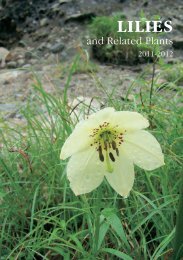LILIES - RHS Lily Group
LILIES - RHS Lily Group
LILIES - RHS Lily Group
Create successful ePaper yourself
Turn your PDF publications into a flip-book with our unique Google optimized e-Paper software.
or Cliftonii <strong>Group</strong> in gardening circles, is horticulturally distinct in that it flowers<br />
noticeably earlier, in fact one of the earliest of all erythroniums, and in my<br />
experience does not have the same propensity to produce stolons.<br />
The unique pink E. revolutum is perhaps the most prolific species in Britain,<br />
especially in the higher rainfall western side of the country. One can see large<br />
drifts in many gardens ranging from the south-west (for example Knightshayes)<br />
all the way up to north-western Scotland at Inverewe. As a wild plant it is also<br />
widespread in a north-south direction at fairly low altitudes from Vancouver<br />
Island to California, and it is very variable. The species is almost entirely<br />
seed propagated so named variants are not clonal although some breed true<br />
enough and have been given cultivar status. So, we have dark pink ones named<br />
‘Johnsonii’ (this was originally described as a species) and other shades such<br />
as ‘Knightshayes Pink’, ‘Pink Beauty’, ‘Rose Beauty’, etc. Species such as this<br />
create a dilemma for those assessing the merits of a plant for the AGM. Should<br />
the award be given to the entire species encompassing all its variations, even if<br />
some might be less pleasing than others, or should only ‘the better’ variants be<br />
acknowledged? There is no real answer but the matter can usually be resolved by<br />
asking oneself: ‘would I throw out any form of E. revolutum on the grounds that<br />
it was inferior?’ In this case I suspect that the answer from most people would be<br />
a resounding ‘no way’! This question does not arise in the case of E. hendersonii,<br />
another western American species which is more restricted in distribution in<br />
southern Oregon and northern California. It varies only a little in the depth of<br />
pale lavender-violet of its flowers which have a distinct dark violet eye in the<br />
centre, a unique colour combination in the genus. As a result of this comparative<br />
uniformity I am unaware of any named cultivars. As with E. revolutum there is<br />
little tendency for the bulbs to produce offsets, so seeds are the only practical<br />
method of propagation.<br />
All the species mentioned so far are from western North America and, quite<br />
frankly, that is where the most striking species occur. Of the remaining species<br />
from that region one could mention a few other very desirable ones which are easy<br />
to cultivate, notably E. oregonum. Although superficially similar to E. californicum<br />
(mottled leaves and white flowers, usually with a zone of dark markings in the<br />
centre) the two are distinct and a check on the width of the stamen filaments<br />
will clarify any uncertainty: slender throughout their length in E. californicum but<br />
wide and flattened at the base, tapering to the apex in E. oregonum. For many<br />
years there has been in cultivation in Britain a variant known as “Sulphur form”, a<br />
pleasing variation with pale sulphur-green flowers. Unfortunately the stock came<br />
without an indication of provenance so I was intrigued to find it also in a garden<br />
in Oregon and, on enquiring, was told that it was the form from Kelley Butte.<br />
Only detailed field studies will shed further light as to whether any botanical<br />
83




